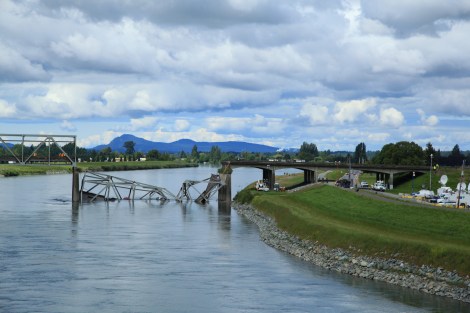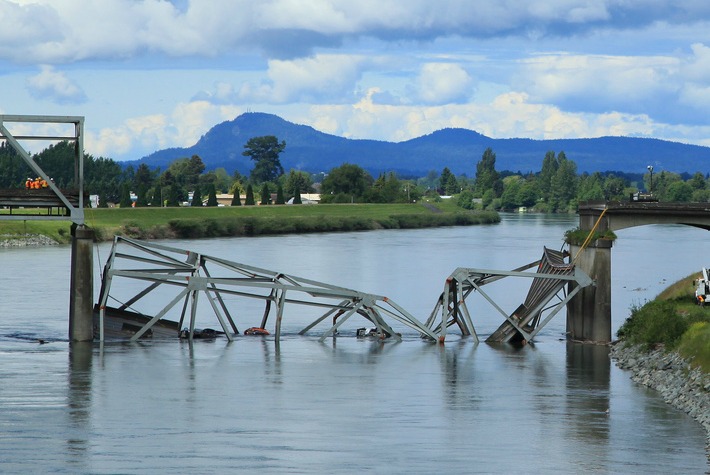The collapse of an Interstate 5 bridge in Washington state Thursday night offered a wake-up call about the sorry state of disrepair in which we’ve left our country’s auto-centric transportation system. But all the talk about aging bridges and infrastructure drowns out a few larger questions — about how we plan to fund the massive road system we’ve built, and why, with existing roads crumbling, we keep dropping money on more.

WSDOTNo one was killed when an I-5 bridge over the Skagit River in Washington collapsed.
The bridge that collapsed in Washington was built, like many major bridges in the U.S., during the rise of the interstate highway system, circa 1955. That means it had already exceeded by several years the 50-year lifespan typical of American bridges.
Ironically, the bridge in Washington, unlike nearly 70,000 bridges across the country, wasn’t rated “structurally deficient.” It had been inspected as recently as November 2012. But after a half a century, a bridge is likely to need major upgrades of some kind, and with the average bridge in this country now 43 years old, we’re looking at a huge roster of bridges due for repairs. According to the Federal Highway Administration, as of 2009, the backlog of deficient bridges required $70.9 billion to address — and that number has likely increased since then.
So what are states doing to tackle the problem? They’re funneling money to shiny new construction projects instead, natch. According to Transportation for America, a national coalition for transportation policy reform:
In recent years, most transportation agencies have delayed needed repairs and maintenance while focusing their energy on new construction. In 2008, all states combined spent more than $18 billion, or 30 percent of the federal transportation funds they received, to build new roads or add capacity to existing roads. In that same year, states spent $8.1 billion of federal funds on repair and rehabilitation of bridges, or about 13 percent of total funds. States currently have the ability to “flex” or transfer out up to 50 percent of their bridge repair money into other projects or programs. [emphasis theirs]
“The new stuff, the ribbon-cutting, always competes with maintenance,” says David Goldberg, communications director at Transportation for America, noting that Washington state’s most recent transportation package allocated surprisingly little money to repair and replace existing structures.
“Some [new] projects have merit and are important for economic development,” Goldberg adds. “But a lot of them have strong political backing. [Departments of Transportation] across the country know that bridges [like the one in Washington] need to be replaced [eventually]. But are they going to spend the money to replace a bridge that is still technically OK when they’re being tapped on the shoulder by politicians saying, ‘Hey, we really want you to spend the money on this shiny new mega-project?’”
Politicians advocating for such mega-projects get to throw around the magic word — jobs. But Transportation for America reports that “Repair work on roads and bridges generates 16 percent more jobs than construction of new bridges and roads,” and that over 25 years, deferring maintenance can end up costing three times as much as preventive repairs. And with public transit ridership at record highs despite constant fare hikes and service cuts, does pouring money into increased road capacity really make sense?
Larry Hanley, international president of the Amalgamated Transit Union, doesn’t think so. “There’s no better example of being penny-wise and pound-foolish than the way Congress is refusing to adequately fund our transportation infrastructure,” he said in a statement. “Their legislative intransigence will lead to much greater expense down the road when too many people find it impossible to get to work or to shop, or to do any one of the many things people do that keep our economy moving.”
As Goldberg puts it: “If [a new project] shaves two minutes off a typical commute, and probably only for 10 years, is this a worthwhile project? With dwindling resources, it becomes more and more important to really prioritize. We need to make sure we’re doing key repairs first.”
Why are resources dwindling? I’ll let Grist’s Greg Hanscom explain:
In the past, much of the transportation system has been paid for using federal and state gas taxes … But cars are becoming more efficient, meaning we’re burning less fuel and paying less in gas taxes, and while the cost of maintaining our roads has risen steadily, the federal gas tax [rate] has remained the same since 1993. To make matters worse, thanks to a drowsy economy, Americans are driving less and buying less stuff that needs to be shipped cross-country.
Gas taxes go into the Highway Trust Fund, which is quickly running dry, despite emergency refills from the general fund. Governing magazine reports that Congress would have to either cut transportation funding by 92 percent (!) or raise the gas tax by at least 50 percent in order to save the fund.
Raising the gas tax is a politically touchy subject, especially when gas prices are already high. But a report from last year found that 58 percent of Americans would support a 10-cent increase in the gas tax, if they knew it would go toward maintenance of existing roads and highways. Incidents like this latest bridge collapse — to say nothing of the tragic 2007 collapse of a Minneapolis bridge that killed 13 people — could certainly bolster that support.
Goldberg predicts a gas-tax hike could be a feasible short-term solution to bolster the fund’s revenue. But, he said, “we need to be looking longer-term and planning for a transition to other sources. … so that [the fund] incorporates other sources of energy that fuel the next generation of vehicles.”
Goldberg also argues we need a “true comprehensive transportation trust fund, not just a highway trust fund,” and I would agree. Our transportation policy ought to look beyond cars and roads and consider all the diverse and creative ways in which we’re now getting around. And with more money directed to public transit, rail, and bike and pedestrian infrastructure, we wouldn’t be so dependent on ever-growing roads in the first place.




